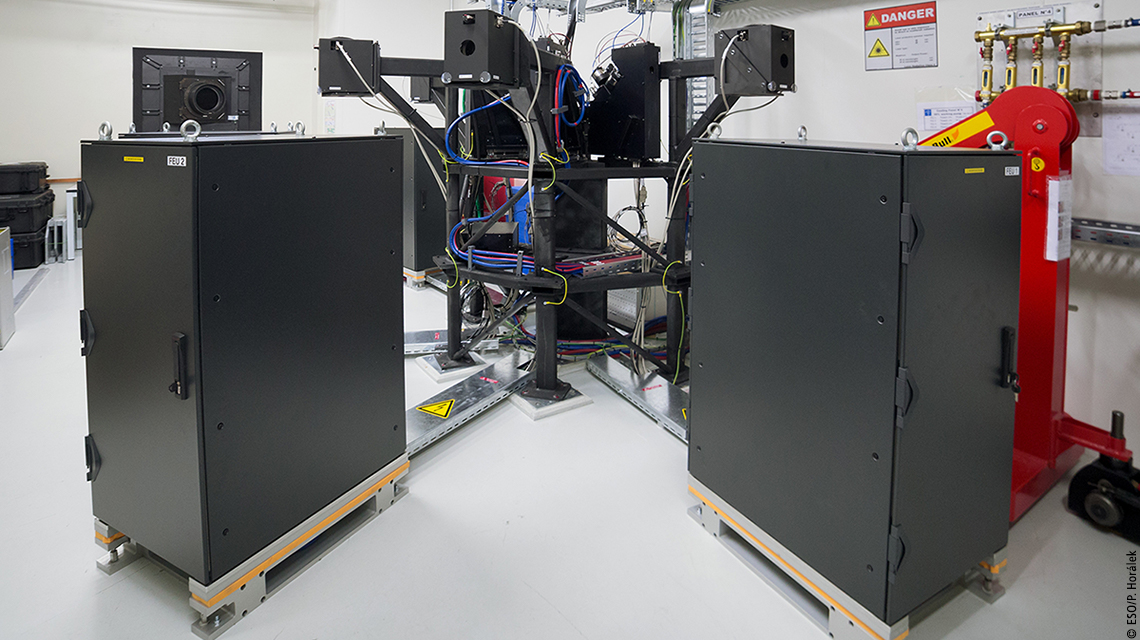

PC-based control technology upgrades large telescopes and other instruments at the European Southern Observatory
Observations made with ESO’s Very Large Telescope (VLT) revealed for the first time in 2020 that a star orbiting the supermassive black hole at the center of the Milky Way moves just as predicted by Albert Einstein’s general theory of relativity. This long-sought-after result was made possible by high-precision measurements, in which PC-based control technology from Beckhoff played a key role as it has with other experiments.

The European Southern Observatory, (ESO), which is headquartered in Garching, Germany, is the leading European organization for astronomical research and the world’s most scientifically productive observatory. ESO carries out an ambitious program focused on the design, construction and operation of powerful, ground-based astronomical observation facilities. The organization has three observation sites in Chile: La Silla, Paranal and Chajnantor. At Paranal, ESO currently operates the Very Large Telescope (VLT), the VLT Interferometer, and the two survey telescopes, Vista and the VLT Survey Telescope. Moreover, ESO selected Cerro Armazones, not far from Paranal, as the home for the Extremely Large Telescope (ELT), which at 39 m in diameter is scheduled to go into operation in 2025 as the largest optical telescope in the world.
Black hole at the center of the Milky Way
Einstein’s general theory of relativity predicts that the gravitational orbit of one celestial body around another is not closed, as in Newtonian Gravity, but that the orbital ellipse itself undergoes rotation in the direction of motion around the attracting body. This “star dance” effect was proven in 2020 in the motion of a star orbiting the compact radio source Sagittarius A* at the center of the Milky Way. It also proves the presence of a supermassive black hole of 4 million times the mass of the sun. This effect, known as Schwarzschild precession, had never before been measured for a star moving around a supermassive black hole.
This result is the culmination of 27 years of observations of this star using, for the better part of this time, a variety of advanced instruments at ESO’s VLT, located in the Atacama Desert in Chile. The number of data points marking the star’s position and velocity attests to the accuracy of the new research project: more than 330 measurements in total were performed using the “Gravity” instrument among others. Because the star takes years to orbit the black hole, it had to be followed for close to three decades in order to unravel the intricacies of its orbital movement.

PC-based control used in upgrades and new instruments
Due to its lengthy period of operation, the VLT uses older control technology for the most part, but PC-based control from Beckhoff is already being used now in some of the more recent upgrades. One example of this is the modernization of the UT Coudé Train, via which the starlight from the individual telescopes is passed on to the front-end units, spectrographs and detectors. As explained by Mario Kiekebusch, Head of Instrument Control Software Group at ESO: “Beckhoff technology is now being used in a number of systems at the observatory, primarily in second- and third-generation astronomical instruments. The first instrument to be implemented fully with Beckhoff control systems is the Echelle Spectrograph for Rocky Exoplanet and Stable Spectroscopic Observations (Espresso). By detecting minimal changes in the light properties of stars, it can be used to search for exoplanets with unprecedented precision. The light of all four VLT telescopes can now also be combined for the first time, thus achieving the light-collecting power of a 16 m telescope.”
According to Mario Kiekebusch, Gravity is another very important instrument that uses Beckhoff controllers. This instrument already helped confirm the existence of a black hole in our galaxy, and is used to combine the light from all four VLT 8 m telescopes in one super telescope offering the resolution of a telescope of up to 130 meters in diameter. Four controllers are used on average for each instrument, primarily CX20xx series Embedded PCs. TwinCAT 3 is the control software used, generally with the basic runtime components TwinCAT 3 PLC/NC PTP 10 (TC1250) and TwinCAT 3 C++ (TC1300), as well as the TwinCAT 3 OPC UA function (TF6100).
About 10 EtherCAT Terminals are directly connected to each Embedded PC acting as PLC on average. According to Mario Kiekebusch, the most commonly used of these are the ES2xxx and ES3xxx digital and analog input and output terminals and communication interfaces like the EL6002 serial interface. Additionally, the stepper and DC motion controllers used include the EL7041 stepper motor terminal with EL5152 external encoder terminal and the EL7342 DC motor terminal with the EL5101 incremental encoder interface. Moreover, future plans for the ELT include the use of around 560 EL2044 four-channel digital output terminals with extended diagnostics.